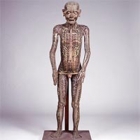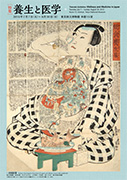Japanese Gallery (Honkan) Room 15
July 7, 2015 (Tue) - August 30, 2015 (Sun)
In the mid-Edo period (1603?1868), Japanese medicine made remarkable progress as a result of the introduction of Western medicine, which was called “Dutch Studies.” In contrast, the practice of maintaining wellness had been exercised in Japan from long ago. Today, various approaches to maintaining wellness are attracting attention from the view point of preventive medicine.
In Japan, “wellness” entailed methods of attaining perpetual youth and longevity, as well as the philosophy of how to live one’s life. How was “wellness” put into practice during the Edo period? When medicine was not as advanced as it is today, people, first of all, pondered how to avoid sickness. They attempted to prevent sickness by making use of familiar things around them: they kept at home traditional medicinal herbs, such as chameleon plants, to infuse, or practiced moxibustion to strengthen their lower bodies.
This exhibition showcases objects that are important for analyzing the relationship between wellness and medicine in Japan. These include models of human bodies showing acupuncture and moxibustion points, which were the foundation of Eastern medicine, anatomical models of human bodies, which were influenced by Western medicine, and a set of portable surgical tools that belonged to the German doctor, von Siebold (1796?1866). The exhibits also contain relevant books, including volumes from the oldest medical book in Japan, and ones on wellness in general that people referred to on a daily basis.


